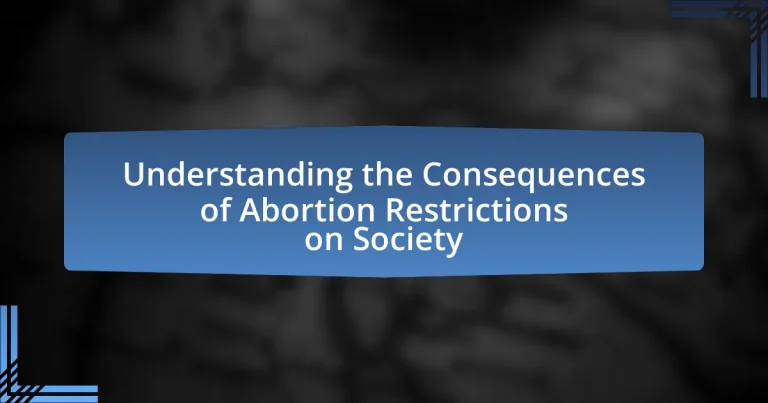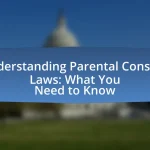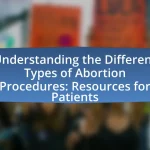The article examines the societal consequences of abortion restrictions, highlighting their impact on women’s health, economic stability, and public health expenditures. It details how such restrictions lead to increased rates of unsafe abortions, higher maternal mortality, and exacerbated socioeconomic disparities, particularly affecting marginalized groups. Additionally, the article discusses the mental health implications for women denied access to abortion, the influence of political ideologies on abortion laws, and the broader economic consequences of limiting reproductive healthcare access. It emphasizes the need for comprehensive policies and community resources to mitigate these negative effects and promote reproductive rights.
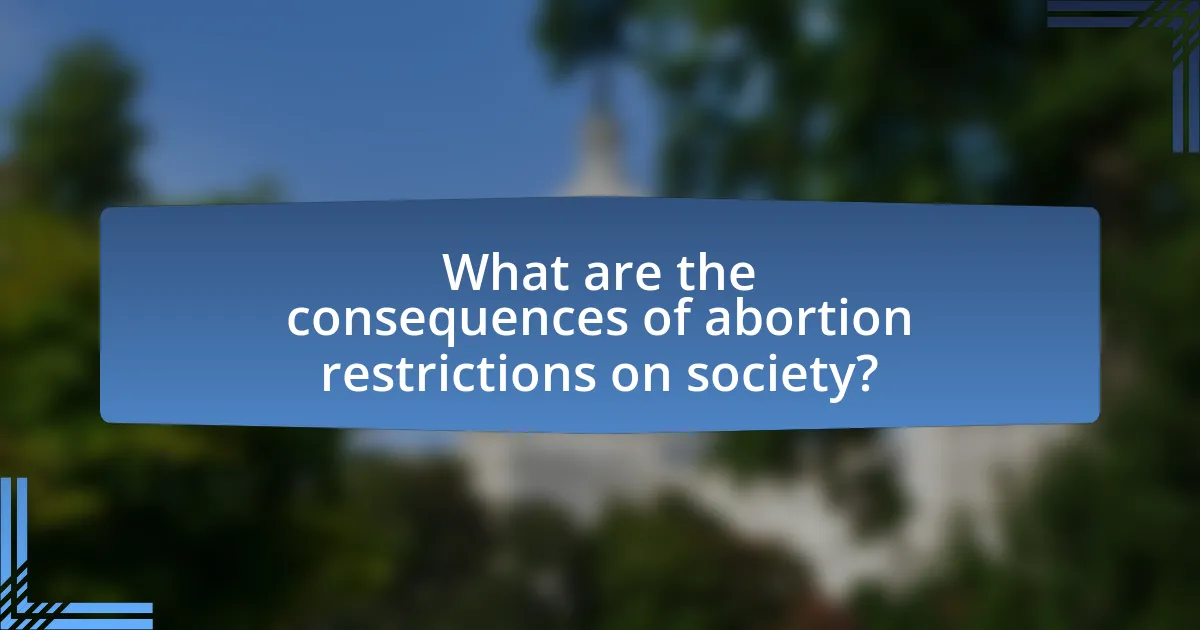
What are the consequences of abortion restrictions on society?
Abortion restrictions lead to significant societal consequences, including increased rates of unsafe abortions, higher maternal mortality, and economic burdens on families and healthcare systems. Research indicates that in regions with strict abortion laws, such as in parts of Latin America, unsafe abortions account for a substantial percentage of maternal deaths, with the World Health Organization estimating that 47,000 women die annually due to complications from unsafe procedures. Additionally, restrictions can exacerbate socioeconomic disparities, as marginalized groups often lack access to safe reproductive healthcare, leading to increased poverty and health inequities. These factors collectively strain public health resources and can hinder overall societal progress.
How do abortion restrictions impact women’s health?
Abortion restrictions negatively impact women’s health by limiting access to safe and legal abortion services, which can lead to increased rates of unsafe procedures and associated health complications. Research indicates that in regions with stringent abortion laws, women are more likely to resort to unsafe methods, resulting in higher rates of maternal morbidity and mortality. For instance, a study published in The Lancet found that countries with restrictive abortion laws have significantly higher rates of unsafe abortions, contributing to an estimated 47,000 maternal deaths annually worldwide. Furthermore, restricted access can exacerbate mental health issues, as women may experience increased anxiety and depression due to unwanted pregnancies and lack of support.
What are the physical health risks associated with restricted access to abortion?
Restricted access to abortion significantly increases physical health risks for individuals. These risks include higher rates of unsafe abortions, which can lead to severe complications such as hemorrhage, infection, and injury to internal organs. According to the World Health Organization, approximately 25 million unsafe abortions occur each year, primarily in regions with restrictive abortion laws, resulting in an estimated 47,000 deaths annually. Additionally, individuals may experience long-term health issues, including chronic pain and infertility, due to complications from unsafe procedures. The lack of access to safe abortion services directly correlates with increased maternal morbidity and mortality rates, highlighting the critical health implications of such restrictions.
How do mental health outcomes change with abortion restrictions?
Mental health outcomes typically worsen with abortion restrictions. Research indicates that individuals denied abortions experience higher rates of anxiety, depression, and lower life satisfaction compared to those who can access abortion services. A study published in the American Journal of Psychiatry found that women who were denied an abortion were more likely to experience significant mental health challenges, with 29% reporting anxiety and 25% reporting depression one week after the denial. In contrast, those who received the abortion reported improved mental health outcomes, highlighting the negative impact of restrictive abortion laws on psychological well-being.
What social implications arise from abortion restrictions?
Abortion restrictions lead to significant social implications, including increased economic hardship for women and families, limited access to healthcare, and heightened social stigma surrounding reproductive choices. Research indicates that women denied abortions are more likely to experience poverty and economic instability, as evidenced by a study published in the American Journal of Public Health, which found that women who were denied abortions were four times more likely to fall below the federal poverty line compared to those who received the procedure. Additionally, restrictions can exacerbate health disparities, as marginalized groups often face greater barriers to accessing reproductive healthcare, leading to poorer health outcomes. The social stigma associated with abortion can also result in isolation and mental health challenges for women, further complicating their social and economic situations.
How do abortion restrictions affect family dynamics?
Abortion restrictions significantly impact family dynamics by increasing stress and conflict among family members. Families facing unplanned pregnancies due to these restrictions often experience heightened emotional and financial strain, leading to disagreements about parenting, financial responsibilities, and future plans. Research from the Guttmacher Institute indicates that restrictive abortion laws correlate with higher rates of family instability, as families may struggle to adapt to unexpected changes in their circumstances. This instability can manifest in various ways, including increased domestic tension and a greater likelihood of separation or divorce, as families navigate the challenges imposed by limited reproductive choices.
What role do abortion restrictions play in socioeconomic disparities?
Abortion restrictions significantly contribute to socioeconomic disparities by limiting access to reproductive healthcare, which disproportionately affects low-income individuals and marginalized communities. These restrictions often lead to increased financial burdens, as individuals may face higher costs associated with carrying an unwanted pregnancy to term, including healthcare, childcare, and lost income. Research indicates that states with more restrictive abortion laws experience higher rates of poverty and lower educational attainment among women, as unintended pregnancies can hinder their ability to pursue education and stable employment. For instance, a study published in the American Journal of Public Health found that women denied abortions were more likely to fall into poverty compared to those who were able to obtain the procedure, highlighting the direct link between abortion access and economic stability.
How do abortion restrictions influence public opinion and activism?
Abortion restrictions significantly shape public opinion and activism by polarizing views and mobilizing advocacy efforts. When restrictions are enacted, they often provoke strong reactions from both supporters and opponents of abortion rights, leading to increased activism. For instance, studies show that states with more restrictive abortion laws experience higher levels of public protests and organized campaigns advocating for reproductive rights. According to a 2021 report by the Guttmacher Institute, states that implemented stringent abortion laws saw a 20% increase in pro-choice activism, highlighting how restrictions can galvanize public sentiment and action. This dynamic illustrates that abortion restrictions not only influence individual beliefs but also catalyze collective movements aimed at challenging or supporting these laws.
What trends are observed in public attitudes towards abortion following restrictions?
Public attitudes towards abortion tend to become more supportive of access following the implementation of restrictions. Research indicates that in regions where abortion laws have tightened, there is often a corresponding increase in public advocacy for reproductive rights. For instance, a study by the Guttmacher Institute found that after states enacted restrictive abortion laws, public opinion shifted, with a notable rise in support for legal abortion among demographics previously opposed. This trend is often driven by increased awareness of the implications of restrictions, including the potential for unsafe procedures and the impact on women’s health and autonomy.
How do abortion restrictions mobilize advocacy groups and movements?
Abortion restrictions mobilize advocacy groups and movements by creating a sense of urgency and galvanizing collective action among individuals who oppose these limitations. When laws are enacted that restrict access to abortion, organizations such as Planned Parenthood and the American Civil Liberties Union often respond by organizing protests, lobbying efforts, and public awareness campaigns to challenge these restrictions. For instance, the 2019 passage of restrictive abortion laws in several U.S. states led to widespread mobilization, resulting in the Women’s March and various local demonstrations aimed at protecting reproductive rights. This mobilization is further fueled by the emotional and personal impact of such laws, as individuals share their stories and experiences, thereby fostering a community of support and activism.
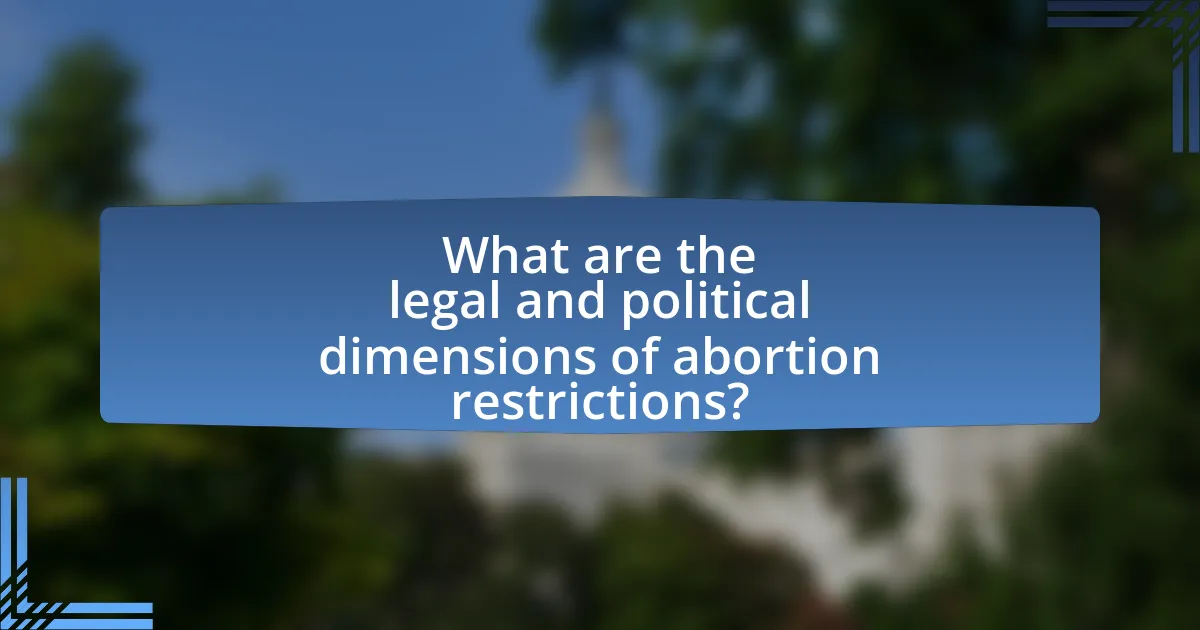
What are the legal and political dimensions of abortion restrictions?
Abortion restrictions encompass legal frameworks and political dynamics that govern access to abortion services. Legally, these restrictions can include laws that limit the circumstances under which abortions can be performed, such as gestational limits, mandatory waiting periods, and parental consent requirements for minors. Politically, abortion restrictions are often influenced by the ideological positions of lawmakers, public opinion, and advocacy from various interest groups, including pro-life and pro-choice organizations. For instance, the Supreme Court’s decision in Roe v. Wade (1973) established a constitutional right to abortion, but subsequent rulings and state-level legislation have created a patchwork of access across the United States, reflecting the contentious political landscape surrounding the issue.
How do different countries approach abortion legislation?
Different countries approach abortion legislation with varying degrees of restriction and accessibility. For instance, countries like Canada and the Netherlands have liberal laws that allow abortion on request during the first trimester, reflecting a focus on women’s rights and health. In contrast, nations such as Poland have stringent laws that permit abortion only in cases of severe fetal abnormalities or threats to the mother’s life, highlighting a more conservative stance influenced by cultural and religious factors. According to the World Health Organization, approximately 25% of countries have highly restrictive abortion laws, which can lead to unsafe procedures and significant health risks for women.
What are the most common legal frameworks governing abortion worldwide?
The most common legal frameworks governing abortion worldwide include liberal, restrictive, and prohibitive laws. Liberal frameworks, found in countries like Canada and the Netherlands, allow abortion on request during early pregnancy. Restrictive frameworks, seen in nations such as the United States and many European countries, permit abortion under specific circumstances, such as health risks or fetal anomalies. Prohibitive frameworks, present in countries like El Salvador and Nicaragua, ban abortion entirely, often leading to severe legal consequences for those who seek or provide the procedure. These frameworks reflect varying cultural, religious, and political attitudes towards reproductive rights and significantly impact women’s health and societal outcomes.
How do cultural factors influence abortion laws in various regions?
Cultural factors significantly influence abortion laws across various regions by shaping societal attitudes, religious beliefs, and historical contexts surrounding reproductive rights. For instance, in predominantly Catholic countries like Poland and Ireland, strong religious opposition to abortion has led to restrictive laws, reflecting the cultural emphasis on the sanctity of life. Conversely, in more secular societies such as Sweden and the Netherlands, cultural acceptance of individual autonomy and gender equality has resulted in more liberal abortion laws, allowing for greater access to reproductive healthcare. This correlation between cultural values and legal frameworks is evident in the varying degrees of legal restrictions and societal support for abortion, demonstrating how deeply ingrained cultural beliefs can dictate the legal landscape regarding reproductive rights.
What are the implications of judicial rulings on abortion access?
Judicial rulings on abortion access significantly impact the availability and legality of abortion services, influencing women’s reproductive rights and health outcomes. For instance, the U.S. Supreme Court’s decision in Roe v. Wade (1973) established a constitutional right to abortion, which led to increased access for women across the country. Conversely, subsequent rulings, such as the 2022 Dobbs v. Jackson Women’s Health Organization decision, overturned Roe, resulting in numerous states enacting restrictive laws that limit or ban abortions, thereby reducing access for many women. These judicial decisions can lead to increased health risks for women, economic disparities, and social inequities, as access to safe and legal abortion services is often correlated with socioeconomic status and geographic location.
How do landmark court cases shape abortion rights?
Landmark court cases shape abortion rights by establishing legal precedents that define the extent of reproductive freedoms. For instance, the 1973 Supreme Court decision in Roe v. Wade recognized a woman’s constitutional right to privacy, effectively legalizing abortion nationwide and setting a standard that influenced subsequent rulings. This case established that states could not impose excessive restrictions on abortion access, thereby shaping the legal landscape for reproductive rights. Additionally, cases like Planned Parenthood v. Casey in 1992 reaffirmed Roe while allowing some state regulations, demonstrating how judicial interpretations can evolve and impact abortion rights over time. These rulings collectively influence legislation, public policy, and societal attitudes towards abortion, highlighting the significant role of the judiciary in shaping reproductive rights.
What is the impact of state-level legislation on abortion access?
State-level legislation significantly impacts abortion access by either expanding or restricting availability based on the laws enacted. For instance, states that have implemented restrictive laws, such as mandatory waiting periods, parental consent requirements, and gestational limits, have seen a decrease in the number of clinics providing abortion services. According to the Guttmacher Institute, states with more restrictive abortion laws have experienced a 20% decline in the number of facilities offering abortions since 2011. Conversely, states that protect abortion rights through supportive legislation tend to maintain or increase access, demonstrating a clear correlation between legislative action and the accessibility of abortion services.
How do political ideologies affect abortion policy?
Political ideologies significantly influence abortion policy by shaping the legal frameworks and societal attitudes surrounding the issue. For instance, conservative ideologies typically advocate for restrictive abortion laws, emphasizing the protection of fetal life and often aligning with religious beliefs that oppose abortion. In contrast, liberal ideologies generally support reproductive rights, advocating for access to safe and legal abortion as a matter of personal choice and bodily autonomy.
Evidence of this influence can be seen in the United States, where states governed by conservative leadership have enacted laws that impose strict regulations on abortion access, such as mandatory waiting periods and limitations on when abortions can be performed. Conversely, states with liberal leadership have implemented policies that protect and expand access to abortion services, reflecting a commitment to reproductive rights. This ideological divide not only affects legislation but also impacts public opinion and the availability of resources for individuals seeking abortions.
What role do political parties play in shaping abortion laws?
Political parties significantly influence the formulation and modification of abortion laws through their platforms, legislative agendas, and control of government positions. For instance, in the United States, the Democratic Party generally supports pro-choice policies, advocating for women’s rights to access abortion services, while the Republican Party typically endorses pro-life stances, aiming to restrict or ban abortions. This ideological divide shapes state and federal legislation, as party members often vote along party lines, impacting the passage of laws related to abortion. Historical evidence shows that when a party holds a majority in legislative bodies, it can enact laws that reflect its stance on abortion, such as the various state-level restrictions implemented by Republican-controlled legislatures since 2010.
How does political polarization influence public discourse on abortion?
Political polarization significantly influences public discourse on abortion by creating stark divisions in opinions and framing the debate in binary terms. This polarization leads to heightened emotional responses, where individuals align strongly with their political identities, often disregarding nuanced perspectives. For instance, research from the Pew Research Center indicates that as of 2021, 61% of Democrats support legal abortion in all or most cases, while only 27% of Republicans share this view, illustrating the deep ideological divide. Consequently, this division results in a discourse that is often characterized by hostility and misinformation, making constructive dialogue challenging and reinforcing existing societal divides.
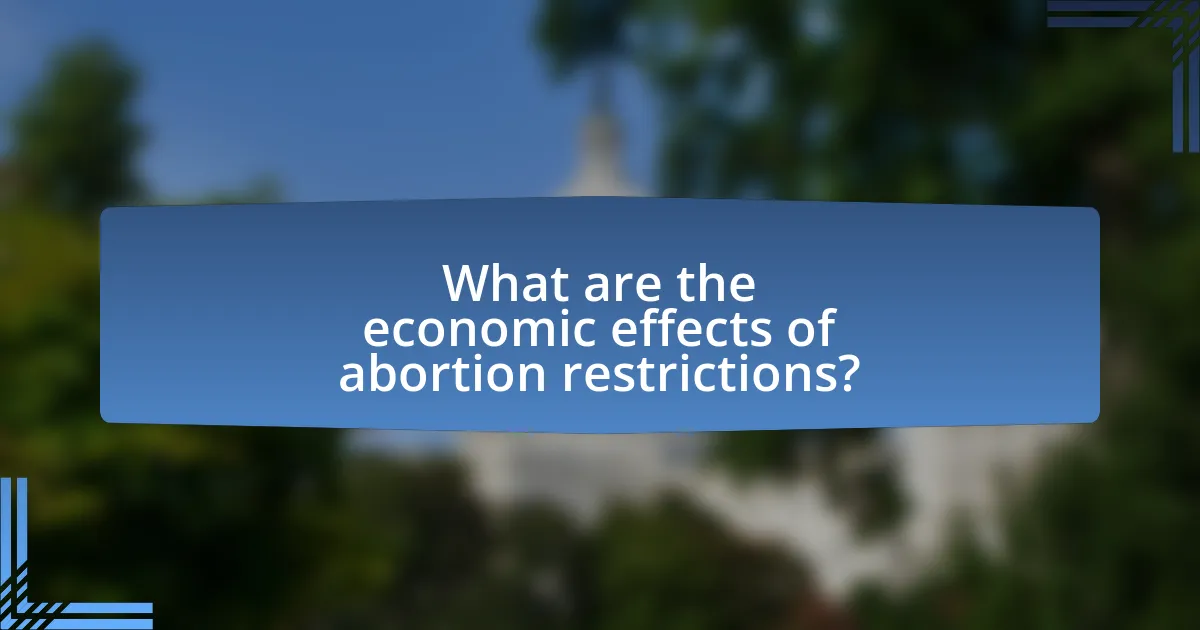
What are the economic effects of abortion restrictions?
Abortion restrictions negatively impact economic outcomes by limiting women’s access to reproductive healthcare, which can lead to increased poverty rates and reduced workforce participation. Studies show that women who are denied abortions are more likely to experience economic hardship, with a 2017 study published in the American Journal of Public Health indicating that 78% of women who sought abortions reported that having a child would push them below the poverty line. Additionally, restrictions can lead to increased healthcare costs due to higher rates of unintended pregnancies and associated complications. The Guttmacher Institute reports that states with more restrictive abortion laws often see higher rates of maternal and infant mortality, further straining public health resources and economic stability.
How do abortion restrictions impact healthcare costs?
Abortion restrictions increase healthcare costs by limiting access to safe and legal abortion services, which can lead to higher expenses for unintended pregnancies and related healthcare needs. When individuals are unable to obtain abortions, they may face increased costs associated with prenatal care, childbirth, and postnatal care. For instance, a study published in the American Journal of Public Health found that states with more restrictive abortion laws saw a significant rise in Medicaid expenditures for childbirth and infant care, with costs estimated to be over $200 million annually in some cases. Additionally, complications from unsafe abortions can lead to higher medical costs due to emergency care and hospitalization, further burdening the healthcare system.
What are the financial implications for women denied access to abortion?
Women denied access to abortion face significant financial implications, including increased costs associated with raising an unplanned child. The average cost of raising a child in the United States is estimated to be around $233,610 from birth to age 17, which can place a substantial financial burden on women, particularly those already in precarious economic situations. Additionally, women may experience lost income due to time taken off work for childbirth and childcare, with studies indicating that women who have children are more likely to experience a decrease in their earnings compared to those who do not. Furthermore, the inability to access abortion services can lead to increased reliance on public assistance programs, further straining government resources. These financial challenges highlight the broader economic impact of restricting access to abortion services.
How do abortion restrictions affect public health expenditures?
Abortion restrictions increase public health expenditures by leading to higher rates of unintended pregnancies and associated healthcare costs. When access to abortion is limited, women may resort to unsafe methods or carry unwanted pregnancies to term, resulting in increased expenditures for prenatal care, childbirth, and postnatal care. A study published in the American Journal of Public Health found that states with more restrictive abortion laws experienced higher rates of maternal morbidity and mortality, which in turn escalates healthcare costs. Additionally, the Guttmacher Institute reported that the economic burden of unintended pregnancies can exceed $5 billion annually in the United States, highlighting the financial implications of restricting abortion access on public health systems.
What are the broader economic consequences of restricting abortion access?
Restricting abortion access leads to significant broader economic consequences, including increased healthcare costs, reduced workforce participation, and negative impacts on family income. Studies indicate that women denied abortions are more likely to experience economic hardship, with a 2019 report from the Institute for Women’s Policy Research showing that 73% of women who sought abortions cited financial constraints as a primary reason. Additionally, restricted access can result in higher rates of unintended pregnancies, which can strain public resources and healthcare systems. The Guttmacher Institute found that states with more restrictive abortion laws often face higher rates of maternal and infant mortality, further burdening economic systems. Overall, these factors contribute to a cycle of poverty and economic instability for families and communities.
How do abortion restrictions influence workforce participation among women?
Abortion restrictions negatively influence workforce participation among women by limiting their reproductive autonomy and economic opportunities. When women face barriers to accessing abortion services, they may experience increased financial instability, which can deter them from pursuing or maintaining employment. Research indicates that states with more restrictive abortion laws see a decline in women’s labor force participation rates; for instance, a study published in the American Journal of Public Health found that women in states with stringent abortion laws were 10% less likely to be employed compared to those in more permissive states. This correlation suggests that the inability to make choices about reproduction directly impacts women’s ability to engage fully in the workforce.
What is the relationship between abortion access and economic stability in communities?
Abortion access is positively correlated with economic stability in communities. When individuals have the ability to make choices about reproduction, they are more likely to pursue education and employment opportunities, leading to increased economic productivity. Research from the Guttmacher Institute indicates that women who can access abortion services are more likely to remain in the workforce and achieve higher levels of education, which contributes to overall economic growth in their communities. Additionally, a study published in the American Journal of Public Health found that restrictions on abortion access can lead to increased poverty rates and economic instability, as unintended pregnancies can strain financial resources and limit opportunities for advancement.
What strategies can mitigate the negative economic impacts of abortion restrictions?
Implementing comprehensive sex education and access to contraception can mitigate the negative economic impacts of abortion restrictions. These strategies reduce unintended pregnancies, which in turn lowers the demand for abortions and associated economic burdens. For instance, research from the Guttmacher Institute indicates that states with comprehensive sex education and contraceptive access experience lower rates of unintended pregnancies, leading to improved economic outcomes for women and families. Additionally, supporting policies that enhance maternal and child health services can further alleviate economic strain by ensuring that women have the resources needed to support their families effectively.
What policies can support women facing unintended pregnancies?
Policies that can support women facing unintended pregnancies include comprehensive access to reproductive healthcare, including contraception and abortion services, as well as financial assistance programs for prenatal care and childcare. Research indicates that states with expanded Medicaid programs have seen improved maternal and infant health outcomes, demonstrating the effectiveness of financial support in reducing barriers to care. Additionally, policies that promote parental leave and workplace accommodations can help women manage the challenges associated with unintended pregnancies, further supporting their health and economic stability.
How can community resources be mobilized to address the consequences of abortion restrictions?
Community resources can be mobilized to address the consequences of abortion restrictions by establishing support networks that provide access to healthcare, education, and financial assistance. Local organizations can collaborate to create comprehensive care programs that include counseling services, transportation to clinics, and financial aid for those seeking reproductive health services. For instance, studies have shown that community-based organizations can effectively reduce barriers to care by offering resources tailored to the specific needs of individuals affected by abortion restrictions, such as the Guttmacher Institute’s research indicating that states with strong community support systems see better health outcomes for women. By leveraging existing community assets and fostering partnerships, these resources can significantly mitigate the negative impacts of restrictive abortion laws.
